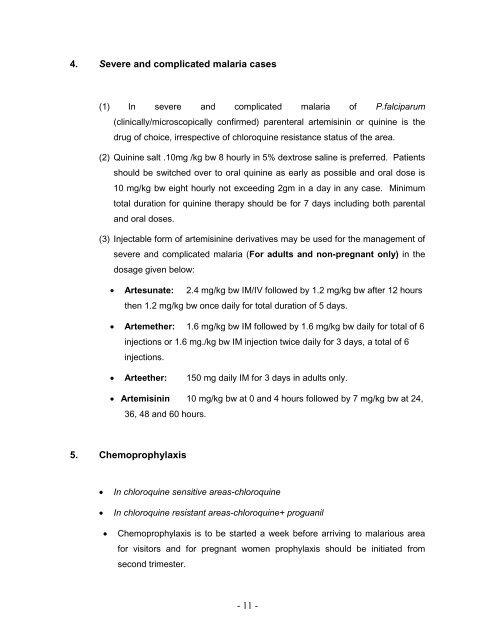MALARIA DRUG POLICY (2007) - NVBDCP
MALARIA DRUG POLICY (2007) - NVBDCP
MALARIA DRUG POLICY (2007) - NVBDCP
You also want an ePaper? Increase the reach of your titles
YUMPU automatically turns print PDFs into web optimized ePapers that Google loves.
4. Severe and complicated malaria cases(1) In severe and complicated malaria of P.falciparum(clinically/microscopically confirmed) parenteral artemisinin or quinine is thedrug of choice, irrespective of chloroquine resistance status of the area.(2) Quinine salt .10mg /kg bw 8 hourly in 5% dextrose saline is preferred. Patientsshould be switched over to oral quinine as early as possible and oral dose is10 mg/kg bw eight hourly not exceeding 2gm in a day in any case. Minimumtotal duration for quinine therapy should be for 7 days including both parentaland oral doses.(3) Injectable form of artemisinine derivatives may be used for the management ofsevere and complicated malaria (For adults and non-pregnant only) in thedosage given below: Artesunate: 2.4 mg/kg bw IM/IV followed by 1.2 mg/kg bw after 12 hoursthen 1.2 mg/kg bw once daily for total duration of 5 days. Artemether: 1.6 mg/kg bw IM followed by 1.6 mg/kg bw daily for total of 6injections or 1.6 mg./kg bw IM injection twice daily for 3 days, a total of 6injections. Arteether: 150 mg daily IM for 3 days in adults only. Artemisinin 10 mg/kg bw at 0 and 4 hours followed by 7 mg/kg bw at 24,36, 48 and 60 hours.5. ChemoprophylaxisIn chloroquine sensitive areas-chloroquineIn chloroquine resistant areas-chloroquine+ proguanilChemoprophylaxis is to be started a week before arriving to malarious areafor visitors and for pregnant women prophylaxis should be initiated fromsecond trimester.- 11 -
















